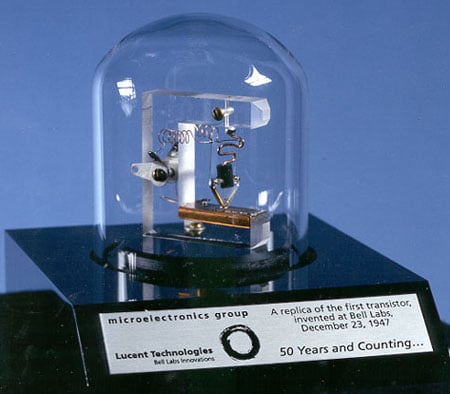Crotchety, Old Transistor Turns 65 Today. Now Get Off My Lawn!
The transistor, the fundamental base to all of our electronic devices, turns 65-years-old today. Though the concept of a transistor had been worked on decades earlier, it was on December 16, 1947 when John Bardeen and Walter Brattain operated the first transistor based on a point-contact design. Gold sheets were used as point contacts, separated by plastic, which ran to a piece of germanium that sat atop a metal base. A clunky design, but a working one.
While the point-contact transistor was put into production, William Shockley not long after developed a much more compact and easier-to-manufacture transistor based on the bipolar junction design. For their research, Shockley, Bardeen and Brattain were each awarded a Nobel Prize for Physics in 1956.

In the early 50s, Bell Labs began licensing Shockley's junction transistor design, but these were just the beginning. In the late 50s, Bell Labs' employees John Atalla and Dawon Kahng discovered Metal-Oxide Semiconductor technology, which eventually led to CMOS transistors (C for contemporary).
By this point, you could say that things had really begun accelerating. In 1958, Jack Kilby and Robert Noyce combined transistors to create the first integrated circuit chip, and in 1971 released the first microprocessor - the Intel 4004, sporting a grand total of 2300 transistors. By comparison, even today's modest desktop processors contain hundreds of millions of transistors, with some breaking past the 1 billion mark. To say that a lot has been accomplished since Bardeen and Brattain created their point-contact transistor would be a gross understatement.
So without further ado, Happy 65th, transistor!

